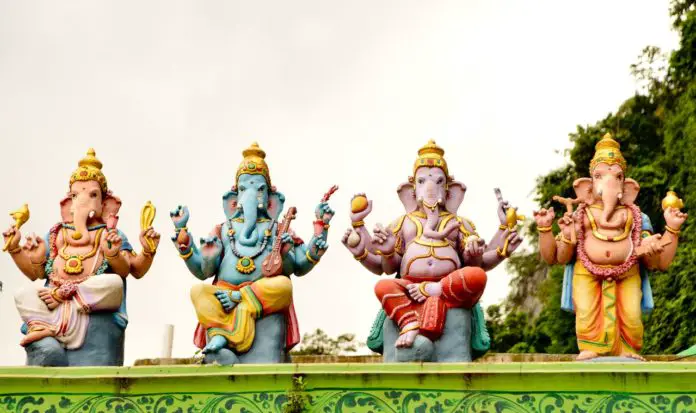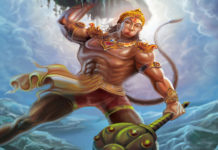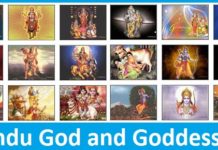Symbolism and Iconography in Hindu Theology: A cursory research on India and Hinduism will have you browsing through thousands of images of colorful festivals, impossible yoga poses, and more importantly, Indian gods and goddesses with several arms. Where would you start if you wanted to take a shot at wrapping your head around centuries of theology which deifies more than 300 million Indian gods and goddesses with several arms, and/or heads? Well, the good news is that there is a core that you can start with, and avenues you can choose for yourself to branch out from.
The origins of Hinduism go back to a time before writing existed. More than a religion, it (was) is a set of socio-religious beliefs and practices. Several countries boast of a sizable number of Hindu devotees, but Hinduism had its seeds in India, and it thrives even today. Wherever you go in India, you are sure to find a temple, or a sacred grove, or shrine to a local deity, which may seem a strange form of the divine to an outsider.
When you dive into a study of Hinduism two things stand out immediately: the sheer number of their gods and goddesses, and their penchant for symbolism and layers of meaning.
The More The Merrier! – How Many Indian Gods And Goddesses?
To start at the very beginning, let’s look at the concept of Hinduism as a polytheistic religion. The Hindus are a people who fiercely reject the teaching of monotheism. At this stage you will be tempted to draw similarities between Greek and Hindu mythology, but you will immediately see that Hinduism goes a lot deeper and embraces a wider culture of gods and goddesses – around 330 million, in fact.
According to their teachings, there are several truths and several ways to reach those truths. Devotion to deities and gods or goddesses are a matter of personal choice. Neither religious texts, nor sacred figures, or theological teachers or priests can claim to be absolute in understanding, power, or knowledge of the scriptures. There are several interpretations, belief-systems, and ways of living. These may often seem to contradict the other, but when viewed in the light of Oneness manifesting itself in different ways to different people, we begin to understand where this tolerance comes from.
Indian Gods With Many Arms: Symbolism At Its Best
The next stage to understanding this religion is to learn that nothing is simple. Now,any outsider will immediately recognize the vital role that idols and images play in Hindu worship. Sight is a vital part of their worship.
So, why are idols such a big deal? A particular sacred text called the Vishnudharmottara Purana answers this question in this way: idols and images showcase an avenue for the god or goddess to be relatable and approachable to his devotees. Whatever form the god or goddess takes is also the form that is fulfilling an immediate need of the devotee. So, while each avatar is usually taken as a different god, it is usually a part of a greater god’s identity. Everything, in the end, comes from one indestructible, all-powerful source.
Why The Bizarre Representation?
Depictions of these deities not only show them as larger-than-life, but quite human, and yet different from humans at the same time. Most of them have been given recognizable human forms, but have at least one extra set of limbs, and in some cases, multiple heads, eyes, etc.
Showcasing the Indian gods and goddesses with many arms and other body parts points towards something more – there is a rich context of symbolism and iconography in Hindu theology, over and above the legends and stories of the religious texts.
The dress, posture, facial expressions, and objects that gods and goddesses are depicted as holding are all symbolic of their role and power. The bizarre visualization is an attempt to condense all the different roles and the magnitude of power into dimensions that human devotees can understand. Exploring the deeper meaning of these symbols is a very interesting study. Pandits often complain that Hinduism is often misunderstood, even by devotees themselves, as the symbolism and iconography behind objects and expressions is ignored. They emphasize that it is important to step beyond the physical depictions and meditate on the spiritual truths they embody.
Iconography & Symbolism: Layers Of Meaning In Depicting Indian Gods With Many Arms
Symbolism and iconography in the Hindu religion make it one of the most visually vibrant religious cultures in the world. Devotional art in the form of statues, sculptures, art and music explode with adoration for gods and goddesses, and there is a sizable body of art that has evolved, and continues to evolve in this genre.
It is interesting to note that the religious artist representing a god or goddess in his or her art is bound by a set of strict rules and is expected to adhere to an iconographic template. As clearly seen the images bear human-like forms but are represented in various forms of super-human strength, through the multiplicity of their heads and arms. This may not mean that the devotee thinks of the god or goddess as multi-limbed, or multi-headed. It is a symbolic representation which gives you information about the deity in question.
So, What’s The Deal With Multiple Arms And/Or Heads?
In Hindu iconography the multiplicity of arms is meant to represent massive power and the ability to do more than one thing at the same time. Many heads could represent an all-seeing, all-understanding avatar. Limbs are not the only parts of the deity’s body that are meant to be symbols. The goddess Durga, for example, sometimes has three eyes, indicating that she is able to see the past, present, and the future. Brahma’s four heads symbolize the four Vedas, among other things.
According to pandits of Hindu iconography the representation of the gods and goddesses and their various avatars seem to fall under the following categories: santa, vira, or ugra.
Santa, or peaceful icons mostly have either 2 or 4 arms. (as seen in Ganesh and Goddess Lakshmi)
Vira, or heroic icons are represented with 2, 4, or 6 arms. They are usually represented in confrontation with an evil force. (think Hanuman)
Ugra, or wrathful icons have 6 or more arms, and are usually represented in full battle array. (As seen with goddesses Kali and Durga).
It is said that these arms are not all visible at the same time when the gods and goddesses are characterized in legends and stories. These appear when the need arises, or when the situation calls for it. Isn’t it interesting that this reflects our own nature? – we play different roles in different situations in our lives.The various tools and ‘weapons’ made available to us enable us to fulfill those roles to the best of our abilities. This also extends to the relationship devotees have with their deity. The god or goddess makes him/herself accessible to the devotee whenever or wherever he/she needs them.
The number of heads and arms associated with the god or goddess are as symbolically significant as the ornaments they wear, or the instruments, tools, or weapons they carry.
GETTING TO KNOW THEM: STUDYING EXAMPLES OF INDIAN GODS WITH MANY ARMS
In all the repertoire of the gods and goddesses in Hinduism, several are depicted with more than two arms: 4, 6,8, even more!
Let’s take a closer look at some of the most important Indian gods and goddesses with many arms and/or heads.
Brahma:
The Creator and the Source of all the cosmos. One of the most significant features of the representations of Brahma is the lack of weapons in any of his four hands. He also has four heads, indicating that he sees in all directions – a prime example of an Indian God with many hands, and heads! His vehicle of choice is Hamsa, the swan that depicts grace. He is also sometimes depicted as seated on a large lotus, depicting enlightenment. Other symbols associated with him include:
- A lotus flower, here symbolizing Nature, or the living spirit in all things
- Books, symbols of knowledge, usually meaning the Vedas
- A spoon or ladle, usually a sacred instrument used in sacrifices, denoting that he is the lord of spiritual sacrifices
- A jar of holy water
- And the akshamala, with which he keeps track of Universal Time
Vishnu:
Vishnu is often pictured as blue-skinned. This in itself evokes the imagery of the sky, which is endless and bears no particular form. His ‘vehicle’ is a fierce eagle called Garuda, also a symbol. Vishnu is depicted with four arms and hands, each of which hold a sacred object that points to a deeper pursuit for man to pursue. Some of these include a lotus, a conch, the mace, and the discus or chakra.
This god is credited with having the greatest number of incarnations among the gods. As the preserver and protector God, Vishnu is obliged to take on various forms, or avatars.
Some of his most famous avatars include:
- Kurma the turtle who bore a mountain on his back
- Narasimhan the half-man, half-lion who killed a demon to save his Vishnu-devotee son
- Vamana, the dwarf who subdued King Mahabali
- Parasuraman, the axe-wielding sage who killed the thousand-armed king
- Rama, the hero of the epic Ramayana
- Krishna, the king of Dwarka, the main character in Bhagavata Purana and Mahabharata, as well as the one who recites the Bhagavad Gita, and
- The Buddha, the thinker
Shiva:
Lord Shiva is the destroyer of the Universe. He destroys to make way for re-birth, new creation and new ideology. He is worshipped as the originator of Yoga and dance. He has been depicted with 4 or eight arms, or even more. His ‘vehicle’ is the ox, a symbol of strength and faith.
Shiva is seen in various postures, his most common ones being the seated meditation pose and the many-armed dancer pose. His most common instruments and weapons include:
- The three-pronged trident, called the Trisula, used to fight off enemies of evil
- A drum called the Damaru, emitting the sounds of creation and development
- The Fire of Creation
- Hand gestures called mudras which are used in yoga and dance
Durga, warrior-goddess:
If you perform a Google search for ‘Indian god with several arms’, the goddess Durga and her several-armed avatar will be seen at the top of the results-page. Durga Mata may be one of the most visually recognized of the Hindu goddesses, beside Kali Mata.
The goddess Durga is the warrior avatar of the goddess Parvati. She is the Hindu deity of war and is often seen vanquishing forces of evil and demonic influence that negate peace, prosperity and Dharma. The Sanskrit word durga means fortress, or protected place, a place that is difficult to reach.
In most depictions, Durga is riding a tiger or lion, bearing a weapon in each hand, often
defeating Mahishasura. This is symbolic of her role of defeating evil forces like jealousy, anger, prejudice, malice, and the ego.
Durga is endowed with as many as 18 arms- the epitome of an Indian god with many arms! She is said to be the fierce mother avatar of Parvati, only slightly less intense than Kali. The weapons in her hands include a mace, a sword, a disc, arrow and trident, among others. These numerous weapons against the forces of evil are said to symbolize the need for different weapons against different kinds of evil.
A conch is another of her tools. The sound that the blowing of the conch produces is said to symbolize the ultimate victory of Dharma over all evil.
Kali:
The goddess Kali can be described as one of the most striking Indian god with many arms. She is, quite clearly, a terrible power to reckon with. She emerged from the furrowed brow of Durga as she battled with a particularly persistent demon, who was sprouting offspring wherever its blood fell. When Kali appeared at the scene, she was able, not only to lick up the demon’s blood, but also gobble it up whole.
Kali Mata is depicted with 10 arms. There are several factors that are shocking about her. Apart from her ten limbs, terrible grimace and bright red tongue sticking way out, Kali Ma is shown to hold a severed head in one hand, among other weaponry. She is also depicted as half-naked and sporting a necklace of skulls and a skirt made of bones. In many depictions, Shiva lies full-length below her, with one of her legs on the deity’s chest. She is a force to be reckoned with when it comes to vanquishing evil. Along with Ma Durga, she is one of the most worshipped deities among women devotees.
Ganesh:
Lord Ganesh is easily one of the most beloved of the Indian gods with many arms, and one of the most easily recognizable with his elephant’s head. According to legend, he is the son of Shiva and Parvati. Playing the role of ‘Lord of the Obstacles’, devotees turn to him when they experience difficulties that seem like mountains in their lives.
Statues and art of Ganesh portray him in various postures including the dancing pose, and, more commonly, the seated pose. Every aspect of the elephant god’s persona can be taken as a lesson for life. He is usually portrayed with either four or eight arms.
Some of the most common items held in his hands include:
- Part of one tusk: if you look closely, you will find that Ganesh is a single-tusked elephant. According to some legends, this tusk served as a writing tool to finish off the Mahabharata – a symbol of sacrifice to serve a higher purpose.
- A bowl of sweets: these were one of the pleasant-faced god’s favorite treats. It is also meant to show that the pursuit of life should be the attainment of Moksha, which is the sweetest end.
- An axe shows that one is to cut off untoward desire, as it is the root of all evil. It should also be used to fight against ignorance.
- A rope in one hand signifies that one is to keep drawing oneself closer, and effectively tie oneself to the highest goal.
Conclusion: A Starting Point For Studying Indian Gods With Several Arms
I think that’s a great place to start if you want to make a good study of Hinduism as a religion. Of course, that becomes just the tip of a humongous iceberg. The multitude of great, terrible, and lovable Indian gods and goddesses with several arms, heads, weapons and ornaments may become a lifetime of study for you, but definitely something that will be worth it!



